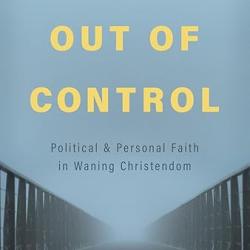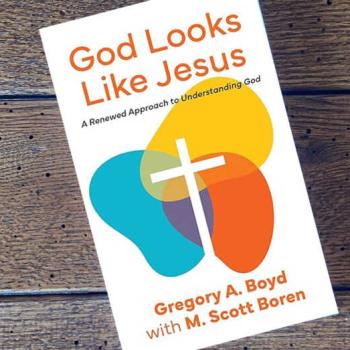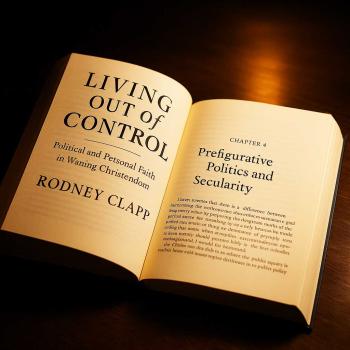Review of Lovin’ On Jesus: A Concise History of Contemporary Worship Plus Thoughts about “Contemporary Christian Music”
Background: Recently here I argued that real Christian worship cannot happen with a “concert atmosphere.” I examined a church’s web site because someone asked me to. There I saw a comment, under “About Us,” that said the church worships with a “concert atmosphere.” I was pleased that at least the church admits it and dismayed that any church would do that. To me, a concert is not a worship service although people can, of course, worship at a concert.
More background: I talked here about visiting numerous evangelical churches over the past several years where the “worship” does seem more like a concert than a worship service. The pattern of church worship services with a “concert atmosphere” is this: Opening music by the worship band followed by some kind of welcome and maybe a call to worship. Sometimes a prayer. Most often the congregation asked to stand and sing with the worship band and worship leader for about thirty minutes. Words projected onto large screens. Often few in the congregation sing; instead they listen and sip coffee and munch on donuts from the coffee bar in the foyer. The worship band has a great time singing the newish songs that were mostly written for performance by a Christian musical artist. Most of the songs have no discernible tune or melody but about five notes that seem random. Much repetition. Shallow lyrics. Virtually no theology. Often, I say, not always. Usually the congregation stands in darkness while the lights are on the worship team. After that the pastor or someone gives a talk, not a “sermon,” that sounds somewhat like a Christian TEDtalk. Lots of emphasis on experience with the main point being encouragement to become dedicated disciples of Jesus Christ. Then more of the worship band playing their instruments and singing songs the congregation can hardly sing because they were written for performance, not congregational singing. Many of the songs can be heard on Christian radio that plays Contemporary Christian Music (CCM). Then the music stops, the worship leader or pastor or someone prays and the service ends.
Okay, now some of you my dear readers have strongly objected to my complaint about this newish pattern of “worship” among youth-oriented churches, many of them very large, many somewhere near a college or university. Fine. I am an old fogey. And I do like to sing hymns. But I also grew up through the so-called “worship wars” and know quite a bit about American evangelical worship.
So someone who seemed to think I’m ignorant about contemporary Christian worship recommended that I read Lovin’ on Jesus: A Concise History of Contemporary Worship by Swee Hong Lim and Lester Ruth (Abingdon, 2017). I got it and have read most of it. I focused especially on the two chapters “The Music of Contemporary Worship.” Here are some of my thoughts about the book and especially those two chapters.
*Sidebar: The opinions expressed here are my own (or those of the guest writer); I do not speak for any other person, group or organization; nor do I imply that the opinions expressed here reflect those of any other person, group or organization unless I say so specifically. Before commenting read the entire post and the “Note to commenters” at its end.*
I take into account that the subtitle contains the phrase “concise history.” Right. It’s very concise. In fact, though, I think it is partly wrong.
First of all, to those of you who have wrongly thought I am opposed to “contemporary worship” or “contemporary Christian music,” you’re wrong. I am only opposed to worship leaders and worship teams singing songs in worship that they expect congregants to sing that most cannot because the songs were clearly written for performance, not congregational singing.
Here is a list of songs mentioned in the book as examples of CCM:
Amazing Grace (My Chains Are Gone), As the Deer, Better Is One Day, Blessed Be Your Name, The Blood Will Never Lose Its Power, Come, Now is the Time to Worship, Everybody Ought to Know, Father I Adore You, The Heart of Worship, How Great Is Our God, I Could Sing of Your Love Forever, I Exalt Thee, I Love You, Lord, In the Name of Jesus, Lord, I Lift Your Name On High, Majesty, Oh, How I Love Jesus, The Power of Your Love, Praise the Lord, Praise the Name of Jesus, Seek Ye First, Shine, Jesus, Shine, Shout to the Lord, 10,000 Reasons, Thou Art Worthy, and a few I left out here because I’ve never heard of them but they are (from the contexts where they are mentioned) like the ones listed here.
I know all those songs, have sung and do sing them, have no complaint about any of them. I would be absolutely thrilled to be part of a worship service where any of them are sung congregationally. And I have been in worship services where they were sung congregationally. All have tunes! Let’s take “Praise the Name of Jesus” (1970). What a great worship song! I love it. If you don’t know it, look it up online. I can’t write lyrics here for copyright reasons.
If this list represented CCM fully I would never complain about it unless the older hymns were completely replaced by them. In the churches I attended from 1970 on, until about 2000, that was not the case. These songs were mixed together with hymns. All were written for both performance and congregational singing.
I have to be careful about naming names here, for obvious reasons, but in the last approximately twenty years a whole new genre of CCM has appeared as almost exclusively sung by worship bands in evangelical churches. Most of them were clearly written for performance by groups like “Casting Crowns.” (I’m not singling out Casting Crowns; I’m only mentioning the band as one example of a new style of CCM that does not translate well from performance to congregational singing (IMHO). I have attended numerous evangelical churches over the past twenty years where this is the case. The worship band is worshiping but also performing newish CCM that I have heard on CCM-formatted Christian radio but that I can’t sing. Apparently many other people can’t sing them either.
Here’s what I notice in these evangelical worship services. When the newish CCM songs are sung by the worship band very, very few people sing with them. But IF they lead in singing a hymn like “Come Thou Fount” or “Crown Him with Many Crowns” or “Great Is Thy Faithfulness” the WHOLE congregation bursts out in loud singing. Usually, though, only one hymn is sung; the rest is all the newish CCM songs written for performance, not congregational singing. The common feature is—they don’t have tunes. They have five or six or seven notes that go up and down in no discernible pattern.
Now, back to the book. I have a complaint about the authors’ “history of contemporary worship.” For the most part, with one or two slight exceptions, they trace CCM back to the Jesus People Movement of the early 1970s and especially to Calvary Chapel and the Vineyard. Let me tell you from life experience deep in American evangelical Christianity, CCM began before then and was not invented by Calvary Chapel, Jesus People, or Vineyard.
I have next to me right now an old album my wife and I own. (We own many albums of CCM from long ago.) How do I know it counts as CCM? The title: “NOW!” by “The Contemporaires.” The date of the album is 1967. Among the songs sung by this Youth for Christ musical ensemble on this album are I Asked the Lord, Teenager, Where Are You Going?, There is More to Life, If You Know the Lord, Stand Up for Jesus, and He Bore My Guilt. Two of the songs were written by then up and coming CCM song writers John W. Peterson and Ralph Carmichael.
Also next to me right now is another old album that some say is dated 1969, but I believe I owned it before that year. In fact, I peddled it door-to-door for Youth for Christ/Campus Life when I was about 15 which was before 1969. I’ve kept it all these years. It’s a unique and very historical album. A scholar of CCM I know personally teaches that it is the first album of CCM. The cover is “psychedelic” and shows a large guitar and the words (if you can read them!) I Looked for Love Ralph Carmichael Contemporary Sounds. Among the songs on the album are I Looked for Love, A Quiet Place, One of These Days, Love Is Surrender (To His Will), and I’m Gonna Go Back. So far as I know all were written by Ralph Carmichael. The album was made by Word, Inc. of Waco, Texas.
As I recall now, the regional YFC director withdrew the album from sales in our region because so many “Christians” objected to the psychedelic cover and the unusual style of music. But all the songs on the album are easily sung by anyone. But they were NOT intended for congregational singing and, so far as I can remember, never were in any of the numerous churches I attended then and since. They were certainly sung at YFC “rallies” and in Campus Life club meetings.
I believe the real origins of CCM lie in Youth for Christ in the 1960s. Also in the many Billy Graham films of the 1960s that contained a lot of new compositions of Christian songs. It’s possible, IMHO, to trace CCM’s birth to the Billy Graham film “The Restless Ones.” Until then, almost all Christian music was “sacred” or “inspirational” music. Something new and different happened with The Restless Ones and it excited Christian teenagers. Not so much our elders.
And I believe the real founder of CCM was Ralph Carmichael who gets one mention in the book. Others who I believe were very instrumental in the birth of CCM get no mention in the book: Kurt Kaiser, Larry Norman, Keith Green, and others. But can you imagine trying to sing congregationally “I Wish We’d All Been Ready?” I can’t. And what about Petra—the first Christian rock band? Not a mention in the book. (I promoted one of the first Petra concerts but nobody then or since so far as I know has ever imagined a congregation singing God Gave Rock’n Roll to You? (Yes, I know it was written by a British band but it became Petra’s early signature song.)
Also, even though the book was published in 2017 it makes no mention of David Crowder who has been for many years now one of the best known CCM composers and artists. How can a book about contemporary worship published in 2017 not mention Crowder?
Also, the book talks about the Australian influence on CCM but fails to mention Townend and Getty! What? They write songs that congregations can sing. Maybe that’s why they aren’t mentioned. Do some people think congregational hymns CAN’T BE CCM?
Obviously I have some problems with the book. I definitely trace CCM and contemporary Christian worship back further than the Jesus People Movement to Youth for Christ. If you think the album I Looked for Love with its psychedelic cover isn’t CCM you’re crazy.
But here’s the thing. Back in the beginnings of CCM you went to concerts and rallies to hear it and bought albums and eight track tapes to listen to it. You didn’t sing it on Sunday morning during worship. And a lot of it was unsingable by a congregation. Back then cutting edge worship leaders knew that. But some of it was singable by a congregation—like the songs listed above that are mentioned in the book. (I attended a Vineyard church way, way back when the movement was quite new and we sang many of those songs. I miss them.)
Now, when I attend many youth-oriented (or would be youth-oriented) evangelical churches especially in large urban areas (and suburbs) I stand and watch and listen to a worship band singing songs neither I nor hardly anybody in the congregation can sing. It’s “concert atmosphere worship.” And it is becoming the norm in growing, youth-oriented evangelical churches. Sometimes I have the feeling the worship band is showing off and not really even intending to lead the congregation in singing.
*Note to commenters: This blog is not a discussion board; please respond with a question or comment only to me. If you do not share my evangelical Christian perspective (very broadly defined), feel free to ask a question for clarification, but know that this is not a space for debating incommensurate perspectives/worldviews. In any case, know that there is no guarantee that your question or comment will be posted by the moderator or answered by the writer. If you hope for your question or comment to appear here and be answered or responded to, make sure it is civil, respectful, and “on topic.” Do not comment if you have not read the entire post and do not misrepresent what it says. Keep any comment (including questions) to minimal length; do not post essays, sermons or testimonies here. Do not post links to internet sites here. This is a space for expressions of the blogger’s (or guest writers’) opinions and constructive dialogue among evangelical Christians (very broadly defined).













